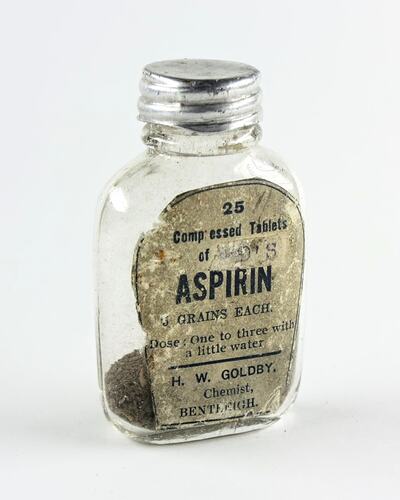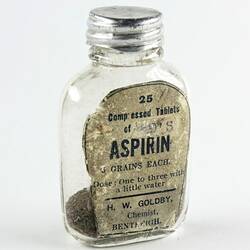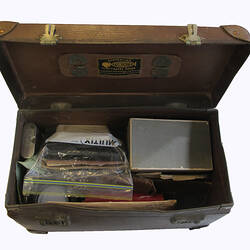Summary
Soil in an asprin bottle made circa 1916-1930 and labelled H.W. Goldby, chemist, of Bentleigh, Melbourne. The soil is a sample of unknown origin, but was possibly collected during service in World War I or locally in Victoria. Preliminary analysis indicates it contains a high level of lead from an unknown source, and potassium nitrate, found in gunpowder. In World War I, however, cordite was more commonly-used than gunpowder; where gunpowder was used, such as for shrapnel shells (to create a smoke screen) the explosion would have consumed the gunpowder. Amongst the botanical material in the sample, a seed of Hyoscyamus niger (common henbane, black henbane) has been identified. Originally from Europe and Asia, it is now a weed plant in Australia, so this seed does not provide a further clue to the origin of the soil. Analysis is continuing.
The bottle item was found inside a small suitcase of belongings from World War I veteran Private Michael Ward (HT 48377). Ward, service no. 4138, was an unmarried 26-year-old farm labourer born in Eddington, Victoria, when he enlisted to serve in World War I on 26 April (attestation 21 March) 1916. He served in the 29th and later the 38th Battalions, and was wounded in knees and hand on 15 April 1918, at Buire in the Somme region of France. He was sent to England for treatment and returned to Australia in late 1918. His discharge from service was delayed until 20 February 1921 because he was still undergoing treatment for war wounds. Michael Ward lived to 72 years of age.
Physical Description
Glass asprin bottle from H. W. Goldby Chemist of Bentleigh, Melbourne. It has a metal screw cap lid and there is a discoloured label on the front with details of contents printed on it in black text. The bottle is approx 1/8 filled with a soil sample.
More Information
-
Collection Names
-
Collecting Areas
Public Life & Institutions, Home & Community, Medicine & Health
-
Previous Owner
Private Michael (. Ward - Australian Imperial Force (AIF), Bentleigh, Melbourne, Victoria, Australia, 1914-1930
-
Manufacturer
Bentleigh, Melbourne, Victoria, Australia
H. W. Goldby, Chemist -
Inscriptions
Front printed in black ink: 25 / Comp[r]essed Tablets / of / ASPRIN / 3 GRAINS EACH / Dose : One to Three with / a little water / H.W.GOLDBY, / Chemist, / BENTLEIGH Handwritten on tape adhered to bottle: D S
-
Classification
-
Category
-
Discipline
-
Type of item
-
References
Location of base hospital and CCS: 'The Long Long Trail' web site [Link 1] accessed 2 June 2016. WARD Michael : Service Number - 4138, National Archives of Australia barcode 8347184. Our Illustrations. (1919, March 1). The Queenslander (Brisbane, Qld. : 1866 - 1939), , p. 29. Retrieved June 20, 2016, from [Link 2] R. Goodall, 'XRF and FTIR Analysis of HT 48575 Mixed Sample in Aspirin Bottle, Michael Ward Collection', Conservation Analysis Report, Museums Victoria, June 2020.
-
Keywords
Military Memorabilia, World War I, 1914-1918, Veterans, Medicines, Chemists, Medicinals & Drugs





